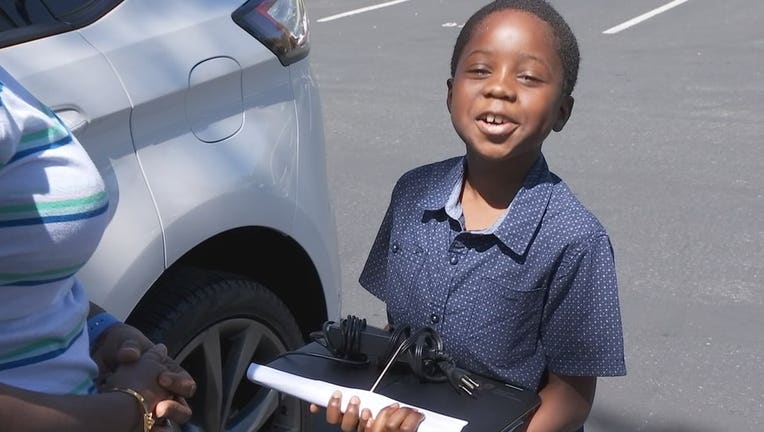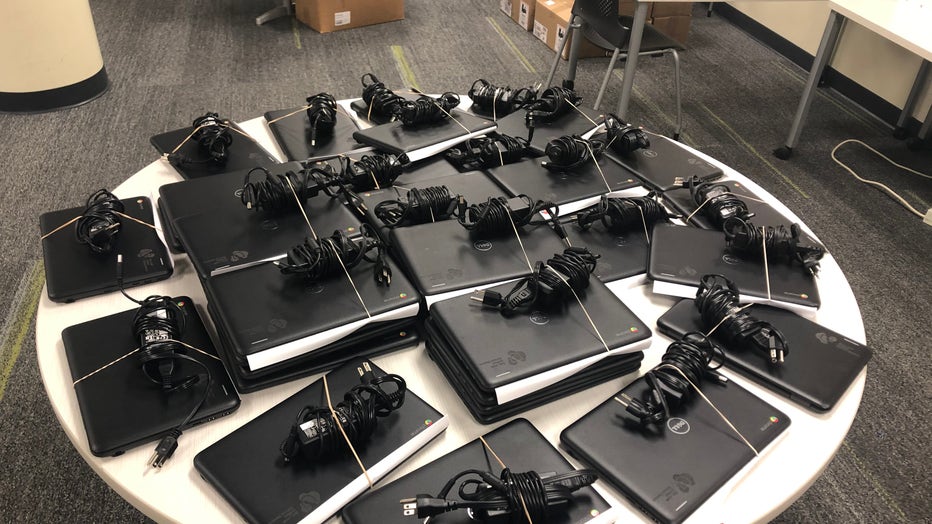'Hundreds of thousands' of California students still lack tech for distance learning

Harold Fofanah picks up a Chromebook at San Jose Unified. April 23, 2020
SACRAMENTO, Calif. - California's top school official said Wednesday that "hundreds of thousands" of the state's public school students still don't have access to the proper technology for distance learning.
It was a startling admission with California's 6 million students set to begin a new school year in a matter of weeks amid an unprecedented focus on online instruction because of the coronavirus pandemic.
Although Superintendent of Public Instruction Tony Thurmond said the state would close the so-called digital divide, district officials in the Bay Area's biggest cities admit they don't even necessarily know how many students need help.
Thurmond said that this lack of laptop computers and broadband internet service is "embarrassing" and disproportionately affects Black and brown students.
"There is no reason for it to exist," Thurmond said, referencing what is known as the "digital divide."
He added that he realizes that it seems "unlikely" this issue will be solved before school starts in about three to four weeks for many districts.
The technology dearth also seems highly problematic, he said, because proper distance learning simply cannot occur without these devices.
However, Thurmond quickly switched gears during a Facebook Live news conference, citing that he made inroads with several internet providers to help students. He emphatically pronounced that he believes the digital divide will be, and must be, bridged. His office did not respond to follow-up questions seeking more specifics.
- California: Digital Divide Fund created to help make distance learning more equitable
- Classwork, communication daunting for million California students with no computers; more donations needed
- Oakland teachers, students demand free access to internet
Across the Bay Area, school districts are scrambling to figure out how to best address their own digital divides. It's estimated that about 20% of all California students, nearly 1.2 million, can’t access the internet at home, a percentage that soars to nearly 50% for poor families and students of color.
But top administrators in San Jose, Oakland and San Francisco acknowledged that they actually have no idea exactly how many students still need access to computers and WiFi at home.
"We just don't know," said Lili Smith, spokeswoman for the San Jose Unified School District, with nearly 30,000 students. "The number is fluid. We don’t know what the situation is for incoming students."
San Jose Unified spent its own money delivering more than 4,000 Chromebooks and about 1,000 hot spots with a free data plan in the spring when in-person classes were abruptly halted in mid-March because of coronavirus.
Smith said that the district will buy any new student a new computer and "will continue to support broadband access for students at home." But at this point, she said she doesn't know how many students that will be. Teachers will be reaching out to students, and families can also contact their principals in advance to let them know what their needs are.

San Jose Unified has distributed about 2,000 Chromebooks so far.
Oakland Unified had one of the more pronounced digital divides.
In April, roughly 17,000 students - out of a total of 50,000 including charter school students - didn't have computers or WiFi, said Seth Hubbert, executive director of Tech Exchange, a nonprofit that provides free and low-cost computers to schools. Hubbert said there were another 8,000 students who might have one computer at home, but several siblings and parents who all have to share it.
Altogether, that's half of the students in Oakland public schools whose technology needs weren't being met at home, he said.
A major fundraising campaign, and a $10 million donation from Twitter CEO Jack Dorsey in May, has closed that gap for the students who didn't have Chromebooks.
But there is still the issue of internet connectivity. At a recent district update, officials said that half the students still don't have adequate WiFi plans.
San Francisco Unified also was able to hand out 12,410 Chromebooks and 3,518 hotspots to students in the spring, according to spokeswoman Laura Dudnick.
But as for how many of the district's 54,000 students still will need computers and WiFi when school starts online on August 17 is anybody's guess.
Not only will there be incoming 3rd graders and new students who will likely need access, Dudnick said that administrators are also trying to figure out how to give kindergarteners through 2nd graders technology if they need computers, too.
"While we know that it is not ideal to have online learning for our youngest students, we recognize that technology is a way for them to connect with each other and their teachers and that this connection is essential," she said.
Kate Steinheimer, a 10th grade English teacher at Phillip and Sala Burton Academic School in San Francisco, said that about 1/3 of her students did not have the right enough computers, internet access or ample data plans when school let out in spring.
Some students had old desktops with no cameras and others had cell phones with limited plans, both of which meant that engaging in vibrant classes on Zoom were nearly impossible for them.
Some of her students, she said, were able to get free computers from the district. But she said she lost contact with several of her students who didn't get the tech, despite texting them and trying to find out how they were.
When online school starts in a month, Steinheimer said she feels prepared to conduct her lessons, but she's quite concerned about how to build personal relationships and a sense of community through a small tablet.
"Especially for the students without cameras, or who don't want to show where they are living, I'll just be looking at black boxes," she said.
IF YOU'RE INTERESTED: The California Bridging the Digital Divide Fund accepts individual contributions at bit.ly/CADigitalDivide. Corporate and institutional donors may contact Mary Nicely at mnicely@cde.ca.gov. For a full list of donors, click here.
This story was reported in Oakland, Calif.
Lisa Fernandez is a reporter for KTVU. Email Lisa at lisa.fernandez@foxtv.com or call her at 510-874-0139. Or follow her on Twitter @ljfernandez

